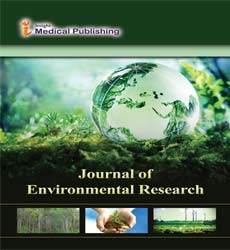HUMAN ECOLOGY AND GROUND WATER SAFETY: RESEARCH PERSPECTIVES
Sudarsan Sahu*
Central Ground Water Board, South Eastern Region, Bhujal Bhawan, Khandagiri, Bhubaneswar, Odisha, India
- *Corresponding Author:
- Sudarsan Sahu
Central Ground Water Board
South Eastern Region, Bhujal Bhawan
Khandagiri, Bhubaneswar, Odisha, India
Tel: +91-9438365741
E-mail: sudarsan_cgwb@yahoo.co.in
Received date: September 04, 2017; Accepted date: September 14, 2017; Published date: September 18, 2017
Citation: Sahu S (2017) Human Ecology and Ground Water Safety: Research Perspectives. J Environ Res Vol.1:No.1:1.
Editorial
Environment plays crucial roles in the survival of plants and animals including the human beings. For sustainable growth of the human society and economies, the preservation and protection of the natural environment with balanced ecology is essential. Soil, air, water and the biospheres therein, and their interrelations need to be understood in a constructive way in order to get maximum benefit out of them for the growth and prosperity of the science and society. Increase in our demand is causing fast draining out of resources that threaten our very survival. Deterioration in the quality of various elements in the environment will have serious consequences in the human health as well as economy by affecting the food and water we consume and the air we breathe.
We all know the importance of water in our lives. Ground water is the largest source of fresh water in the world. For several reasons we have increased our dependency on the groundwater resource. Around 80% of the drinking need and a major part of irrigation in the world is met from the groundwater. The disparity in its availability and any short comings in its quality can affect the lives of millions of people world over. We know, yet ~2 billion people in the world do not have access to the fresh and potable water. We can say human health, growth and economic prosperity of nations depend on the availability of good quality groundwater for various uses.
We should have knowledge based understanding of the groundwater basins and the aquifer systems. Other than interruptions related to human activities some natural and geogenic factors also put limitations on the availability of safe water at places. The chemical constituents in groundwater come in a major way through rock-water interactions and at times some hazardous elements like arsenic (As), fluoride (F) etc. also are released to groundwater in certain hydrogeologic settings. Elevated concentrations of as beyond the drinking limit of WHO (1993) in groundwater has been the major globals threat to human health in different fluvial and fluvio-deltaic regions in the world. More than 100 million people worldwide are exposed to as toxicity through drinking and food supplies. The Bengal Delta Plain (BDP) is the worst affected region of the world. Other than the toxic effects on various organs of human body, high intake as for a prolonged period has been found to be carcinogenic to human health. The problem all started a few decades back when we stopped using dug wells and installed millions of tube wells for abstracting groundwater.
Now the question arises whether we can predict the groundwater as distribution. Organic carbon (OC) rich clayey matter in the sediment column induces reducing environment that releases the adsorbed as in the hydrated iron oxide (HFO). The spread of the reducing front depends upon the hydraulic conductivity, groundwater flow direction, groundwater development (extent and intensity of water level fluctuations) and the volume of fresh oxic water recharge that reaches the spreading anoxic front. Research activities are also highly demanded to ascertain whether the deeper confined aquifers in the contaminated areas can serve safe water for drinking and irrigation in a long term basis.
We should understand the role we are playing in worsening the quality of various natural resources including the groundwater. Indiscriminate groundwater extraction and our indifferent attitude have already inflicted serious damages to the resource availability and scaled up the contamination levels in groundwater systems. We cannot blame the climate change only behind shrinking of the availability of fresh water resources in a global level. Due to unbalanced human ecology groundwater level is depleting fast in various parts of the world, thereby reducing the base-flow in streams/rivers also. Acts like poor urban planning, unnatural practices in agriculture, clearing of forests, taming of rivers etc. have in many instances reduced groundwater recharge and altered its quality. Holistic approaches in human ecological behaviors aided by research activities can restore the environment and save the fresh water resources.
Open Access Journals
- Aquaculture & Veterinary Science
- Chemistry & Chemical Sciences
- Clinical Sciences
- Engineering
- General Science
- Genetics & Molecular Biology
- Health Care & Nursing
- Immunology & Microbiology
- Materials Science
- Mathematics & Physics
- Medical Sciences
- Neurology & Psychiatry
- Oncology & Cancer Science
- Pharmaceutical Sciences
